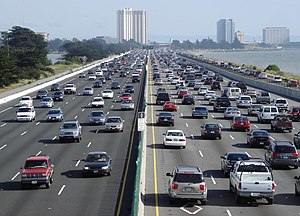
Rising up or falling down? (Photo credit: Wikipedia)
In my hometown, Chicago, the CTA raised fares today. Lots of people are upset, and for good reason. In many cases it’s easy to blame the low hanging fruit – mismanagement, corruption, government waste, high salaries and benefits, etc. Often, the 800 pound gorilla in the room is none of these things. Raising fares is a rational response to a systemic problem in this country – the poor state of good repair as it’s called in the business, or the lack of well maintained infrastructure. It is a lack of a commitment nationwide to maintaining our infrastructure – and the problem is that we’re overbuilt – causing these state of good repair issues. And I don’t mean that we’re overbuilt on transit – it’s the roads, our development pattern and our suburban experiment that is bankrupting us.
CTA, like transit properties nationwide and like Metra here in Chicago, is raising fares in part due to declining federal and state support for capital expenditures and a poor economy that has devastated the operating side of the budget. This is happening all across the country. Therefore, it’s easy to see how transit gets into a situation, a cycle of slow, but perpetual disinvestment on the capital side, not out of poor management, but rather choices in which one must choose the least bad option. Then, the economy goes down, bringing down sales taxes – the principal operating finance mechanism – and now transit is unable to make payroll. This is referred to as the transit “death spiral.”
Transit is in a pickle. In the vast majority of cities it carries just a fraction of the overall work commute. In the Chicago metropolitan statistical area, that number is 11.5%. We’re in fourth place behind New York (31.1%), Washington D.C. (14.8%), and San Francisco (14.4%). It’s difficult to marshall the political forces needed to support transit locally and nationally when only 11.5% of the region’s work trips are made by transit. These numbers are so low precisely because of the built environment we have created. And until the fundamentals of that growth mechanism known as our suburban experiment change, I think the cycle of disinvestment in our infrastructure is likely to continue.




